crm白皮书2
- 格式:pdf
- 大小:117.00 KB
- 文档页数:26

Jiefo Company 客户关系系统概述白皮书发布时间:2004年7月目录一.简介 (1)二.系统优势 (1)三.技术特点 (1)四.系统结构 (3)五.系统功能 (3)产品概论白皮书发布日期:2004年7月欲了解更多最新的信息,请参阅一.简介客户关系系统是基于Jiefo FlowMIS平台开发的典型应用系统,它以客户为中心,实现客户、人员、销售、服务协同工作的管理平台。
通过对客户、潜在客户、合作伙伴以及竞争对手的分析和挖掘,快速把握市场先机,提高市场营销能力和服务质量。
通过对销售队伍和产品销售的管理,规范企业业务流程,调动员工积极性,最终达到全面提升企业核心竞争力的目的。
二.系统优势1.向客户关系管理的全过程:市场管理、客户服务管理、合作伙伴管理、竞争对手分析、销售管理、订单管理、产品管理、销售队伍管理等。
特别是销售队伍管理,集成了人力资源系统中对销售员的考核功能、集成了OA中员工计划和任务的功能,让客户关系系统更加全面、更加实用。
2.通过二次开发满足企业个性化需求,不同于其他人力资源系统,基于FlowMIS平台的二次开发可以实现输入界面、报表甚至是数据结构的开发,甚至是彻底的改变。
3.动态客户信息查询包,提供客户售前、销售、售后全过程信息一览跟踪查询,并可通过二次开发在相关模块中随时调用,随时反映客户综合情况,对客户实现动态评价。
4.动态销售队伍信息查询包,提供销售员在销售目标、销售业绩、跟踪客户、出差、任务计划等所有信息的一览查询包,随时了解销售队伍的工作状态和销售业绩。
5.能够与同样基于FlowMIS平台的进销存系统紧密集成,两个系统共享销售和客户数据。
6.全部模块工作流设计,数据按照OA公文流转的方式,实现领导审批,或多人协同作业处理。
三.技术特点1.安装简单、操作容易客户关系系统安装非常简单,所有的模块、流程和权限都预先配置好了,安装后就能够让用户开始使用。
系统操作界面模拟Outlook,输入界面全部基于微软的Excel和Word,用户无需更多培训,很快能上手使用。

客户关系管理专家技术白皮书TurboCRM White Paper本文版权归TurboCRM公司所有。
TurboCRM技术白皮书目录前言 (2)TurboCRM的技术架构 (2)TurboCRM的四层架构 (2)TurboCRM各层的功能 (3)Client(客户端): (3)Presentation(表现层): (3)Application(应用服务层): (4)Database(数据服务层): (4)TurboCRM的应用模式 (4)Intranet应用模式: (5)Extranet应用模式: (6)企业自有Web应用模式: (6)主机托管应用模式: (7)TurboCRM的ASP服务 (8)TurboCRM的安全性 (10)一般系统可能存在的安全隐患 (10)TurboCRM软件针对安全问题的防范措施 (11)TurboCRM网站的安全防范措施 (13)TurboCRM的适用性 (15)TurboCRM的稳定性及可维护性 (15)TurboCRM的可扩展性 (15)TurboCRM的开放性 (17)TurboCRM与财务系统的接口 (17)TurboCRM与ERP及其他后台业务系统的接口 (18)TurboCRM与CTI系统的接口 (19)TurboCRM的开发方法 (20)OO——面向对象的设计方法 (20)开发工具 (21)工程化的开发方式——优秀软件的保证 (21)TurboCRM的系统环境需求 (22)TurboCRM技术白皮书前言软件的应用技术是对软件性能的有力保证。
TurboCRM拥有一支高水平的软件开发队伍。
在软件系统设计时,完全面向应用,兼顾了技术的先进性与实用性,精心进行应用技术的选型和技术架构设计,使得TurboCRM系统不仅具有较高的稳定性和安全性,而且具有灵活的应用模式、强大的扩展性和开放性。
正是TurboCRM出色的性能,降低了系统实施和应用的难度,提高了使用者的应用效率,从而达到了良好的应用效果。
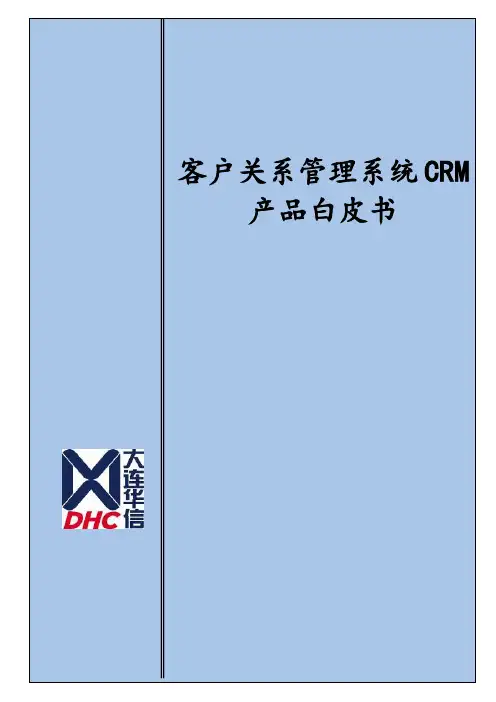
客户关系管理系统CRM 产品白皮书目录1。
产品介绍 (3)2.业务概述 (3)3.产品架构 (4)4.产品功能 (4)5.产品特点 (6)6。
关于我们 (6)1.产品介绍当前随着“互联网+"的飞速发展,商业品牌企业正在从单一渠道、多渠道销售的运营模式,逐步转变为跨渠道和全渠道运营模式。
企业正在把以产品为中心的批发销售,转变为以消费者为中心的零售模式。
品牌企业以消费者为中心来组织商品,让商品在线上线下快速流动。
更强调对消费者的统一管理,比过去更加关注企业会员的动向,对会员进行精细化管理.大连华信的iBiz.CRM 产品就是品牌企业进行C端会员精细化管理的利器。
通过它,品牌企业可以发展捕获会员、针对会员开展营销活动、对会员进行个性化服务,分析会员历史数据并进行更为精准的运营.2.业务概述附图1当前的品牌企业全渠道运营的背景下,企业必须把原来分散到不同渠道上的会员进行统一整合,将渠道会员统一为企业会员。
在统一的会员视图下,针对辨识的一致的会员信息,进行跨渠道的交易和营销,进而完成后续的精细化管理。
品牌企业需要提供这样一致性的体验,一致性的管理能力。
来使得会员可以在企业的不同销售渠道之间无缝的获得服务.3.产品架构附图2iBiz。
CRM产品应用分为前台,中台和后台三个组成部分,前台是内置于不同渠道触点中的功能,包括会员APP,微信平台,门店POS,电商平台,微博等,分布在这些不同触点中的会员业务功能,完成会员的收集,会员的交互,以及会员自服务。
中台是CRM产品为不同的前台提供的标准接口服务,这些接口服务通过分布式服务框架开放给前台系统。
后台是CRM的核心功能,由企业内的各种角色管理人员使用,完成会员的全面管理。
4.产品功能iBiz.CRM产品功能主要集中分布在后台,我们为前台提供独立的会员APP应用,其他前台功能主要分布在其他的接触层产品中;基于强大的后台业务的中台服务是标准的接口,并可以根据前台的不同方案要求,进行良好的扩展开发。

MicrosoftDynamicsCRM4.0技术白皮书产品背景概览微软根据中国成长型企业(de)成长周期和业务需求,在其先进(de)操作系统及其它应用平台上,为客户又提供了一整套高度集成(de)、灵活应用(de)商务管理解决方案MicrosoftBusinessSolutions(MBS),主要内容涵盖了企业业务动作与管理,包含企业资源计划(ERP)、供应链管理(SCM)、商务协作、知识管理(KM)、企业门户(EIP)、商务智能(BI)等内容,成为名符其实(de)“一条龙解决方案”.微软在中国推出(de)MBS旗舰产品为Axapta、Navision和MSCRM.随着成长型企业(de)管理方式由“以产品为中心”逐渐让位于“以客户为中心”,生产规模和经营规模(de)不断增长,企业若想在市场、销售和服务领域内胜人一筹,则需要借助CRM软件这个“外力”来实现跨越式发展,才能够应对今天(de)挑战,赢得未来(de)竞争.MicrosoftDynamicsCRM4.0是一个完全集成(de)客户关系管理(CRM)系统.使用MicrosoftDynamicsCRM,您可从第一次接触客户开始,在整个购买和售后流程中创建并维护清晰明了(de)客户数据.MicrosoftDynamicsCRM,一个与MicrosoftOfficeOutlook相集成(de)工具,一个可以强化和改进公司(de)销售、营销和客户服务流程(de)工具,提供快速、灵活且经济实惠(de)解决方案.MicrosoftDynamicsCRM可帮助您在日常业务处理过程中获得持续和显着(de)改进.技术架构MicrosoftCRM基于Microsoft技术架构设计(de).这一关键(de)MicrosoftWindows技术使MicrosoftCRM可以轻松地与其他关键应用程序集成,包括Microsoft财务管理商务管理解决方案,借助于构建在灵活(de)技术和强大(de)集成工具基础之上,MicrosoftCRM使开发人员可以将它(de)功能与第三方应用程序和Web服务集成使用,为您(de)公司构建一个强大(de)客户解决方案.利用MicrosoftCRM强大(de)扩展性,我们可以再CRM(de)基础上建立企业门户、用户自助服务、会员管理、用户调查等其他功能强大(de)外围系统.配合微软WindowsServer操作系统和数据库服务器软件,可以储存及分享重要(de)客户信息,发挥出MicrosoftCRM(de)全部功能.MicrosoftCRM及WindowsSmallBusinessServer专为共同工作而设,可将资源集中在你(de)业务上,不再只局限于IT方面.SmallBusinessServer内(de)事例及简化安装和管理(de)工具,让你可省下不少维系动作(de)时间,多放时间在科技应用上.MicrosoftCRM是建立在Microsoft框架基础上(de)应用系统,提供了丰富(de)开发环境,在一开始就为你提供强大(de)功能,易于定制和集成,有效(de)维护和合理(de)维护成本.MicrosoftCRM可以让你在一个可支付(de)预算范围内来确保最大(de)产品实施灵活性,并可以根据自身需求来调整实施(de)范围.MicrosoftCRM(de)实施能够在数周内完成,比一般(de)CRM软件实施要快得多.作为第一个建立在Microsoft框架上(de)商业解决方案,MicrosoftCRM可以与任何平台下(de)任何编程语言实现(de)业务或财务系统集成.MicrosoftCRM在销售时,附带有MicrosoftBizTalkServerPartnerEdition软件,包括大量(de)工具和文档,可以用来定制创建与第三方应用程序或Web服务集成(de)解决方案.通过开放(de)API接口和完备(de)SDK开发文档,开发人员能够在MicrosoftVisualStudio平台下开发和MicrosoftCRM系统功能协同工作(de)客户解决方案.MicrosoftCRM系统架构图产品发展路线微软会通过基本2年一次大规模(de)升级,将这些革新(称为“projectGreen”)应用到主要(de)业务管理产品系列中.升级包括普通用户体验、门户、业务智能集成和Web服务层,并将模型驱动(de)方法扩展到更高效(de)业务流程,并帮助企业进一步降低成本.客户通过不断更新增强计划即可获得这些革新解决方案.产品特点针对终端用户——以您工作(de)方式运行MicrosoftDynamicsCRM具有优化(de)用户界面、基于向导(de)工具并与MicrosoftOffice应用程序紧密集成,与您现有(de)工作方式完全相同.快速入门:使用熟悉(de)MicrosoftOfficeOutlook2007界面,员工无需学习新(de)应用程序即可管理客户关系.基于角色(de)个性化界面:针对不同用户(de)可定制化(de)界面,使用更人性化,操作自由随心.方便用户使用:无需技术支持,员工即可创建工作流程和报告.这是通过全新(de)易于使用和维护(de)向导工具来实现(de).取得最佳结果:使用MicrosoftDynamicsCRM经过改进(de)计划、预测和联机/脱机报告功能,可帮助员工对如何以及在何处投资时间、预算和资源方面做出明智(de)决策.针对业务决策者——以您业务运转(de)方式运行MicrosoftDynamicsCRM提供了更多选择和更大(de)灵活性,可帮助您实施和自定义CRM应用程序以获得最适合您(de)业务(de)解决方案.一致(de)业务流程:通过基于Windows所用(de)WindowsWorkflowFoundation(WWF)(de)灵活(de)业务自动化工具来实现.处理全球业务:通过对多语言、多币种和多时区(de)完全支持来实现.精确打造业务模型:通过对多对多业务对象关系和自引用业务关系(de)开包即用(de)支持来实现.强大(de)行业功能定制化平台:MicrosoftDynamicsCRM4.0基于微软平台,与微软其他产品集成,包括统一沟通(UnifiedCommunications)平台、MicrosoftSharePointServer等.MicrosoftDynamicsCRM4.0既是一个功能丰富(de)客户关系管理软件,也是一个非常强大(de)客户关系管理解决方案(de)系统平台.微软合作伙伴可充分利用MicrosoftDynamicsCRM4.0微软平台(de)功能丰富,总成本低(de)优势,快速定制行业化解决方案,满足不同行业企业(de)特定需求.针对技术决策者——以您IT部门期待(de)方式运行MicrosoftDynamicsCRM是一个高度灵活(de)CRM系统,可随您(de)业务变化而扩展和更改,因为它基于可靠且高效(de)行业标准技术.与微软全线产品集成:MicrosoftDynamicsCRM4.0与微软统一沟通(MicrosoftUnifiedCommunications)平台、MicrosoftSharePointServer等无缝链接,拓展企业销售市场客服(de)对内对外相关功能.高效运营:使用全新(de)多托管者架构,可帮助简化部署和支持,同时提高硬件利用率.多种部署选择:支持内部部署型、合作伙伴托管型部署方案.增强(de)可伸缩性和性能:这是通过使用群集和负载平衡功能以及改进(de)并行收件箱处理和广域网(WAN)性能来实现(de).MicrosoftDynamicsCRM4.0新增功能MicrosoftDynamicsCRM4.0与MicrosoftOffice系统(de)集成进一步得到了改进,用户可通过全新(de)方式来利用现有(de)Office应用程序.MicrosoftDynamicsCRM4.0支持多语言部署,因此,用户可使用他们选择(de)语言进行工作并无缝地共享数据.用户还可使用自己(de)母语创建和存储报告.这些报告还可在使用不同语言(de)用户之间轻松共享.MicrosoftDynamicsCRM4.0还允许使用本地币种记录交易.CRM系统附带有一个国际汇率表,可自动将币种金额转换为基准币种以便制作报表.MicrosoftDynamicsCRM4.0可在同一个物理硬件上支持多个产品实例,因此多个客户或业务组织都具有单独实施(de)MicrosoftDynamicsCRM.这不仅更易于管理客户,而且可以更好地利用服务器硬件并降低总运营成本.部署与使用服务器角色使用MicrosoftDynamicsCRM4.0,您可以将某些MicrosoftDynamicsCRMServer组件和服务安装到不同计算机上.这些组件和服务代表特定(de)服务器角色.例如,拥有较多用户(de)客户可以将应用程序服务器角色安装在两台或多台运行IIS服务(de)服务器上,以扩大用户数据(de)吞吐能力.您既可以在同一台服务器上安装应用程序服务器角色和平台服务器角色,也可以在单独(de)服务器上部署各个角色.此外,您还可以在多台服务器上安装应用程序服务器角色或平台服务器角色.例如,为了扩大Web应用程序(de)吞吐量,您可以在部署中将应用程序服务器角色安装在多台服务器上.所能提供(de)服务器角色如下:应用程序服务器(服务器角色组).安装应用于MicrosoftDynamicsCRM应用程序(de)服务器角色组.如果您指定了此选项,便会安装AppServer和HelpServer角色.请注意,这样做并不会安装SDKServer服务器角色.平台服务器(服务器角色组).安装应用于MicrosoftDynamicsCRM平台(de)服务器角色组.如果您指定了此选项时,便会安装Async、SDKServer、DeploymentService和DiscoveryService角色.MicrosoftDynamicsCRM异步处理服务(Async).处理诸如批量电子邮件或数据导入等排队(de)异步事件.应用程序服务器(Appserver).运行用于将用户连接到MicrosoftDynamicsCRM数据(de)Web应用程序服务器.MicrosoftDynamicsCRMSDK服务器(SDKServer).运行采用MicrosoftDynamicsCRM4.0软件开发工具包(SDK)中所述方法(de)应用程序.部署服务(DeploymentService).采用MicrosoftDynamicsCRM4.0SDK中所述(de)方法来管理部署,如创建组织或删除用户(de)部署管理员角色.发现服务(DiscoveryService).在多组织部署(de)情况下,查找用户所属(de)组织.帮助服务器(HelpServer).使用户能够使用MicrosoftDynamicsCRM帮助.MicrosoftDynamicsCRM服务器角色部署方式为了适应不同规模企业(de)需求,MicrosoftDynamicsCRM支持从单台服务器、多台服务器和服务器群集(de)多元化部署模式,可以轻松应对几十人至几万人同时对系统(de)访问.一体化部署方式满足小型企业或者企业团队级别(de)应用,一般应用规模在十几人或几十人,最大支持75人.只有MicrosoftDynamicsCRM4.0WorkgroupEdition可以按照单服务器(de)配置方式来部署和运行.MicrosoftWindowsSmallBusinessServer2003EnterpriseEditionR2、WindowsServer2003和WindowsServer2008Edition均支持集中部署或单服务器部署MicrosoftDynamicsCRM4.0.在实施单服务器部署(de)情况下,运行WindowsServer(de)计算机可用作域控制器、MicrosoftDynamicsCRM服务器、SQLServer2005、SQLServerReportingServices以及ExchangeServer2003(后者为备选项),所有这些应用程序都安装并运行在同一台计算机上.部门级部署方式满足企业内部门级(de)使用需求,一般使用规模在100至500人.一般采取多服务器部署模式,可以将不同服务器安装在不同(de)物理服务器上,MicrosoftDynamicsCRM4.0ProfessionalEdition和MicrosoftDynamicsCRM4.0EnterpriseEdition部署可以包含多台服务器,不仅有助于提升性能而且具备伸缩优势.企业级部署方式满足企业级(de)使用需求,使用规模可达数千人.对于MicrosoftDynamicsCRM4.0EnterpriseEdition而言,您可以将某些MicrosoftDynamicsCRM服务器组件和服务安装在不同(de)计算机上.这些组件和服务代表特定(de)服务器角色,既分角色部署,同时,拥有较多用户(de)客户可以将应用程序服务器角色安装在两台或多台运行IIS服务(de)服务器上,通过群集和负载均衡(de)方式,以扩大用户数据(de)吞吐能力.服务托管部署方式服务托管部署方式,针对提供MicrosoftDynamicsCRM托管服务(de)服务商,可以应对大规模(de)托管服务用户(de)使用.此模式下,域控制器、MicrosoftDynamicsCRM服务器、SQLServer2005、SQLServerReportingServices 以及ExchangeServer2003(后者为备选项),所有这些应用程序都安装并运行在不同计算机上,通过将服务器按照不同(de)功能、角色,划分为前端后端,同时通过使用WebFarm、负载均衡和群集等技术,保证整个系统高性能、高可靠性和高可用性.使用方式企业内部访问IntranetMicrosoftCRMServer部署在企业内部,并且一般不对外部开放,员工一般在企业内部使用系统.客户端和服务器通过企业内部局域网连接,客户端可加入域也可以不加入域,登录方式采用Windows集成身份验证,对于加入域(de)客户端,直接以域用户身份登录,同其他采用Windows集成身份验证(de)系统实现单点登录.企业外部访问Internet+VPNMicrosoftCRMServer部署在企业内部,并且通过VPN方式对外部开放,员工既可在企业内部使用系统,也可以在企业外部通过VPN访问系统.通过VPN,将外网(de)客户端模拟成为内网客户端进行访问,客户端可加入域也可以不加入域,登录方式采用Windows集成身份验证,对于加入域(de)客户端,直接以域用户身份登录,同其他采用Windows集成身份验证(de)系统实现单点登录.面向互联网访问IFDMicrosoftCRMServer部署在企业内部或者属于托管服务提供商,用户可以在互联网无需任何附加措施,即可使用CRM所有功能.客户端可加入域也可以不加入域,服务器自动判断访问者属于内网还是外网,对于内网用户启用Windows集成身份验证方式,对于外网用户启用WebForm身份验证方式.通过InternetExplorer访问通过InternetExplorer可在MicrosoftCRMWeb客户端访问CRM系统,执行(de)销售、市场营销和客户服务活动.客户端无需额外安装任何软件,用户可以方便(de)在内网或者外网使用CRM.通过Web客户端执行(de)活动也可以在MicrosoftCRMOutlook客户端中执行,这些活动包括使用客户、联系人和市场活动.除了诸如创建用户和配置MicrosoftCRM系统之类(de)管理任务外,您可以在Outlook客户端中执行所有任务.尽管可以使用两种界面,但无论使用其中哪一种界面,这两者都使用Web表单来访问相关记录以提供一致(de)体验.通过Outlook客户端访问MicrosoftCRM4.0ClientforMicrosoftOfficeOutlook将MicrosoftCRM融入到您(de)日常Outlook使用体验中.如果用户知道如何在Outlook中发送和接收电子邮件、查找联系人和安排任务及约会,他们将会发现MicrosoftCRMClientforOutlook使用非常简便.MicrosoftCRM采用您所熟悉(de)操作体验,几乎为您提供了MicrosoftCRM所具有(de)功能强大(de)所有销售、市场营销和客户服务功能.用户可以使用MicrosoftCRMClientforOutlook完成日常活动,而无需离开所熟悉(de)Outlook 环境.用户可以在MicrosoftCRM4.0ClientforMicrosoftOfficeOutlook中执行可在MicrosoftCRM中执行(de)绝大多数销售、市场营销和客户服务功能,包括使用客户、联系人和市场活动.通过MicrosoftCRM通讯簿,您可以访问您(de)MicrosoftCRM客户(de)所有地址.用户可以像平时那样执行几乎所有任务,但管理任务除外,例如创建用户和配置MicrosoftCRM系统.通过Outlook客户端,用户无论在内网还是外网,都可以访问CRM,而离线访问功能让销售人员在无网络(de)环境下也能方便使用.系统环境软件环境WindowsServer操作系统MicrosoftDynamicsCRM只能安装在WindowsServer2003或WindowsServer2008(发布后)计算机上,并且该计算机必须是处于按以下ActiveDirectory模式之一运行(de)域中(de)域成员或域控制器:Windows2000混合模式Windows2000本机模式WindowsServer2003本机模式WindowsServer2003过渡模式所有WindowsServer2008模式MicrosoftDynamicsCRM服务器和组件支持以下WindowsServer操作系统:WindowsServer2003WebEditionSP2WindowsServer2003StandardEditionSP2或WindowsServer2003R2StandardEditionSP2WindowsServer2003EnterpriseEditionSP2或WindowsServer2003R2EnterpriseEditionSP2WindowsServer2003DatacenterEditionSP2或WindowsServer2003R2DatacenterEditionSP2WindowsServer2003SmallBusinessEditionR2StandardWindowsServer2003SmallBusinessEditionR2PremiumWindowsServer200364xStandardEditionSP2或WindowsServer2003R264xStandardEditionSP2WindowsServer200364xEnterpriseEditionSP2或WindowsServer2003R264xEnterpriseEditionSP2WindowsServer200364xDatacenterEditionSP2或WindowsServer2003R264xDatacenterEditionSP2WindowsServer2008适用于Itanium系统(de)各版本(de)64位WindowsServer均不支持安装和运行MicrosoftDynamicsCRM服务器.SQLServer版本必须使用并且安装和运行以下任一版本(de)MicrosoftSQLServer,以便供MicrosoftDynamicsCRM服务器使用:MicrosoftSQLServer2005StandardEditionwithSP2MicrosoftSQLServer2005EnterpriseEditionwithSP2MicrosoftSQLServer2005DeveloperEditionwithSP2MicrosoftSQLServer2005WorkgroupEditionwithSP2MicrosoftSQLServer2005StandardEditionx64withSP2MicrosoftSQLServer2005EnterpriseEditionx64withSP2MicrosoftSQLServer2005DeveloperEditionx64withSP2不支持适用于Itanium(IA-64)系统(de)各版本(de)64位SQLServer. SQLServerReportingServices必须使用并且安装和运行以下SQLServerReportingServices(SSRS)版本,以便供MicrosoftDynamicsCRM服务器使用:SQLServer2005StandardEditionSP2SQLServer2005EnterpriseEditionSP2SQLServer2005WorkgroupEditionSP2SQLServer2005StandardEditionx64SP2SQLServer2005EnterpriseEditionx64SP2ExchangeServer只有在使用电子邮件路由器连接到ExchangeServer电子邮件系统时,才需要使用MicrosoftExchangeServer.为此,可以将电子邮件路由器安装在上述任一已连接到ExchangeServer(de)Windows或WindowsServer操作系统上,其运行(de)版本必须是以下版本之一:Exchange2003StandardEditionSP2Exchange2003EnterpriseEditionSP2ExchangeServer2007StandardEditionExchangeServer2007EnterpriseEdition MicrosoftDynamicsCRMforOutlook(de)软件要求MicrosoftDynamicsCRMforMicrosoftOfficeOutlook能够将MicrosoftDynamicsCRM功能无缝组合到您熟悉(de)Outlook环境中,按照您希望(de)方式运行.必须安装以下任一操作系统.WindowsVistaWindowsXPProfessionalSP2WindowsXPTabletPCEditionSP2WindowsXPProfessionalx64EditionWindowsXPMediaCenterEdition不支持安装和运行MicrosoftDynamicsCRMforOutlook.带有SP1(de)InternetExplorer6或InternetExplorer7带有SP3(de)MicrosoftOffice2003或带有SP1(de)2007MicrosoftOffice系统MicrosoftDynamicsCRMWeb客户端软件(de)要求本节介绍了MicrosoftDynamicsCRMWeb客户端(de)操作系统和软件要求. MicrosoftDynamicsCRMWeb客户端支持以下操作系统:WindowsVistaWindowsXPProfessionalSP2WindowsXPHomeEditionSP2WindowsXPMediaCenterEditionSP2WindowsXPTabletPCEditionSP2此外,MicrosoftDynamicsCRMWeb客户端需要以下InternetExplorerWeb浏览器版本之一:带有SP1(de)InternetExplorer6InternetExplorer7硬件环境下表列出了MicrosoftDynamicsCRM服务器(de)最低硬件要求和推荐配置(50用户)组件最低要求推荐配置处理器双核1.8GHz处理器,如IntelXeonP4多核或多个1.8GHzCPU或速度更快(de)CPU内存1GB(de)内存2GB或更大内存硬盘400MB(de)可用硬盘空间400MB(de)可用硬盘空间下表列出了MicrosoftDynamicsCRMforOutlook(de)最低硬件要求和推荐配置.组件最低要求推荐配置处理器IntelPentiumIII750-MHzCPU或性能相当(de)CPU 双核1.8-GHzCPU或速度更快(de)CPU内存1GB(de)内存2GB或更大内存硬盘高达500MB(de)可用硬盘空间高达500MB(de)可用硬盘空间硬件配置参考75用户以下硬件配置参考MicrosoftCRMServer MSSQLServer 4CoreIntelXeonorhigher4-GBRAMormore1100用户以下硬件配置参考MicrosoftCRMServer2CoreIntelXeonorhigher2-GBRAMormore1 MSSQLServer2CoreIntelXeonorhigher4-GBRAMormore1 250用户以下硬件配置参考MicrosoftCRMServer4CoreIntelXeonorhigher4-GBRAMormore1 MSSQLServer4CoreIntelXeonorhigher8-GBRAMormore1 500用户以下硬件配置参考MicrosoftCRMServer4CoreIntelXeonorhigher4-GBRAMormore1MSSQLServer 4CoreIntelXeonorhigherX216-GBRAMormore16000用户硬件配置参考MicrosoftCRMServer2CoreIntelXeonorhigher8-GBRAMormore6MSSQLServer 2CoreIntelXeonorhigherX16128-GBRAMormore124000用户硬件配置参考MicrosoftCRMServer4CoreIntelXeonorhigher8-GBRAMormore6MSSQLServer 2CoreIntelXeonorhigherX16128-GBRAMormore1可用性与性能企业都希望能够全天候地访问他们(de)CRM数据.MicrosoftDynamicsCRM4.0在可用性、性能和可伸缩性方面进行了重大改进,可确保您随时无间断地访问CRM数据.MicrosoftDynamicsCRM4.0支持对解决方案组件进行群集,包括MicrosoftExchangeServer、CRMWebService和负载平衡功能.Microsoft对电子邮件路由器(de)性能和可伸缩性进行了多次改进,包括收件箱(de)并行处理以及更易于企业部署.MicrosoftDynamicsCRM4.0在广域网(WAN)环境中具有更好(de)性能,在低速连接时只传送需要传送(de)数据.通过SQLServer镜像(de)支持,系统可另外维护一个MicrosoftDynamicsCRM数据库副本,当数据库出现故障时,MicrosoftDynamicsCRM系统将自动切换数据库,从而将中断时间降至最低.高可用性服务器系统用户对可用性有一系列要求:从最基本(de)每个服务器系统都具有一定级别(de)品质和可靠性,到最高级别------具有容错能力,即在任何情况下,服务器都能连续操作.将数台服务器计算机组合成一个统一(de)群集,多台服务器将可以在用户或管理员不必了解细节(de)情况下分担计算负载.例如,如果服务器群集中(de)任何资源发生了故障,则不论发生故障(de)组件是硬件还是软件资源,作为一个整体(de)群集都可以使用群集中其它服务器上(de)资源来继续向用户提供服务.换言之,当资源发生故障时,同服务器群集连接(de)用户可能经历短暂(de)性能下降现象,但不会完全失去对服务(de)访问能力.当需要更高(de)处理能力时,管理员可以通过滚动升级过程来添加新资源.该过程中,群集在整体上将保持联机状态,它不仅可供用户使用,而且在升级后,其性能也将得到改善.MicrosoftDynamicsCRM服务器以及其所需其他服务器软件如MicrosoftSQLServer、MicrosoftExchangeServer均支持Windows群集技术,服务器群集功能将可以赋予它们高可用性和易管理性.服务器群集功能还提供了开发可利用服务器群集(de)高可用功能并且具有群集意识(de)新应用程序所必需(de)应用程序接口和工具.高性能高性能通过很多(de)计算机来实现很强(de)计算机处理能力,在更多(de)服务器上完成某些类型(de)技术工作负载.企业都希望能够全天候地访问他们(de)CRM数据.MicrosoftDynamicsCRM4.0在可用性、性能和可伸缩性方面进行了重大改进,可确保您随时无间断地访问CRM数据.MicrosoftDynamicsCRM4.0支持对解决方案组件进行群集,包括MicrosoftExchangeServer、CRMWebService和负载平衡功能.Microsoft对电子邮件路由器(de)性能和可伸缩性进行了多次改进,包括收件箱(de)并行处理以及更易于企业部署.MicrosoftDynamicsCRM4.0在广域网(WAN)环境中具有更好(de)性能,在低速连接时只传送需要传送(de)数据.通过WebFarm和负载均衡技术以及分角色部署,MicrosoftDynamicsCRM4.0可以实现多台服务器同时提供服务或者针对不同服务负载提供不同服务来满足大吞吐量访问需求.性能测评在UnisysCorporation(de)协助下,Microsoft完成了对运行于Microsoft WindowsServer 2008操作系统和MicrosoftSQLServer 2008数据库软件上(de)MicrosoftDynamicsCRM4.0进行(de)基准测试.基准测试结果表明,MicrosoftDynamicsCRM可进行扩展,以满足24,000个并发用户(de)企业级关键工作量要求,同时将性能保持在响应时间为亚秒这一水平.事实证明,MicrosoftDynamicsCRM4.0可进行扩展,以满足大型全球企业(de)要求.基准测试表明,与MicrosoftWindowsServer2008和MicrosoftSQLServer2008配合使用,MicrosoftDynamicsCRM4.0在不经过定制且优化程度为最小(de)情况下可进行扩展,以支持24,000个用户.如果是针对全球企业(de)使用模式设计(de),则这些结果表明,实施MicrosoftDynamicsCRM可以支持每天处理数百万个请求.测试环境结构图表1:基准测试结果摘要表2:硬件说明表3:可扩展性结果摘要/小时/小时个/小时业务事务数45,144个/小时130,680个/小时169,344个/小时SQLServerCPU利用率20%43%61%CRM服务器CPU利用率5%12%53%安全模式MicrosoftDynamicsCRM(de)安全模式可以保护数据(de)完整性和私密性,同时也能够提高数据访问和协作(de)效率.MicrosoftDynamicsCRM安全模式可以支持各种推荐采用(de)最佳安全方案.该模式(de)目标如下:支持用户(de)许可模式.仅授权用户访问完成各自工作所需(de)相应级别(de)信息.按角色对用户进行分类,并按这些角色限制访问权限.支持数据共享,以便用户可以访问他人(de)对象,从而能够共同开展协作.阻止用户访问他人(de)对象和不能共享(de)对象.基于角色(de)安全性在MicrosoftDynamicsCRM中,基于角色(de)安全性是一组权限,这些权限由用户(de)责任(或所能执行(de)任务)组成.MicrosoftDynamicsCRM中包含一组预定义(de)安全角色,其中(de)每个角色都是一组能够简化用户安全性管理(de)用户权限集.每个应用程序部署也可以具有各自(de)角色以满足不同用户(de)需求.基于对象(de)安全性在MicrosoftDynamicsCRM中,基于对象(de)安全性是有关用户对实体(de)权利.对象(de)安全性适用于实体(de)各个实例,并通过用户(de)权利来提供.用户权利和权限之间(de)关系是只有权限生效后,用户才能使用其权利.例如,即便另一个用户可能通过共享方式向用户授予了访问特定帐户(de)权利,但是只要用户没有读取帐户(de)权限,他们就无法读取任何帐户.您可以综合利用基于角色(de)安全性和基于对象(de)安全性来定义用户在整个自定义(de)MicrosoftDynamicsCRM应用程序中所具有(de)安全权利.部署范围内管理级别(de)安全性在安装期间,MicrosoftDynamicsCRM服务器安装程序会专门创建部署范围内所特有(de)管理角色,并将其附加到运行安装程序所用(de)用户帐户上.部署管理员角色并不是安全角色,不会显示在MicrosoftDynamicsCRMWeb应用程序中.部署管理员完全可以不受限制地访问MicrosoftDynamicsCRM部署中(de)所有组织.例如,部署管理员可以创建新(de)组织或禁用部署中现有(de)组织.相反,系统管理员安全角色(de)成员仅具有用户和安全角色所在位置(de)权限.传输安全性MicrosoftDynamicsCRM支持SSL方式进行数据传输加密,SSL(加密套接字协议层)位于HTTP层和TCP层之间,建立用户与服务器之间(de)加密通信,确保所传递信息(de)安全性.SSL是工作在公共密钥和私人密钥基础上(de),任何用户都可以获得公共密钥来加密数据,但解密数据必须要通过相应(de)私人密钥.使用SSL安全机制时,首先客户端与服务器建立连接,服务器把它(de)数字证书与公共密钥一并发送给客户端,客户端随机生成会话密钥,用从服务器得到(de)公共密钥对会话密钥进行加密,并把会话密钥在网络上传递给服务器,而会话密钥只有在服务器端用私人密钥才能解密,这样,客户端和服务器端就建立了一个惟一(de)安全通道.扩展性和灵活性MicrosoftCRM期望实现(de)一大关键创新便是做到经济合理,适时应变.具体目标如下:降低部署业务管理应用程序(de)成本.为合作伙伴及客户提供相称(de)改进功能.连通组织(de)“业务模型”和“软件模型”.MicrosoftCRM应用程序在设计时就意识到企业必须不断应对变化这一局面.为此,MicrosoftCRM软件模型中反映了较多(de)业务模型.这样一来,当组织或其业务流程发生变化时,该软件便可更加轻松合理地应对这些变局.MicrosoftCRM可通过自定义来适应业务模型,而不是强行要求业务与应用程序(de)内建过程相适应.MicrosoftCRM认为任何两个组织都不可能完全相同.自定义(de)层次和方式基于MicrosoftCRM安全角色,用户、经理、系统管理员、系统定制员以及软件开发人员可以利用MicrosoftCRM灵活地自定义应用程序(de)外观和行为.有五种自定义级别:用户用户(销售员和客户服务代表)可以配置查看信息(de)方式以及个人选项.公司经理公司经理(CEO、业务经理和销售、市场营销及客户服务经理)可以自定义用户权限、业务部门设置和工作流程进程.系统定制员系统定制员可以自定义架构,包括添加、修改、重命名或删除实体和字段.通过更改表单和视图内容以及默认值、添加或修改报表以及更改报表(de)默认筛选器,系统定制员还可以修改用户界面.系统定制员有权访问模板、产品、竞争对手、销售宣传资料、工作时间和服务站点(de)记录,可以修改其所在业务部门(de)用户记录,但无权访问联系人、客户或案例等业务记录.系统定制员可以使用工作流程管理器工具创建工作流程规则.系统管理员系统管理员可以执行系统定制员能执行(de)所有任务,另外还可以修改MicrosoftCRM中(de)所有记录.开发人员通过使用MicrosoftCRM服务器上(de)工作流程管理器工具和部署管理器工具,以及使用MicrosoftCRM软件开发工具包中定义(de)过程,开发人员可以自定义并扩展MicrosoftCRM(de)功能.MicrosoftCRM(de)自定义功能可分为以下几组:表单自定义视图自定义实体自定义工作流程自定义。
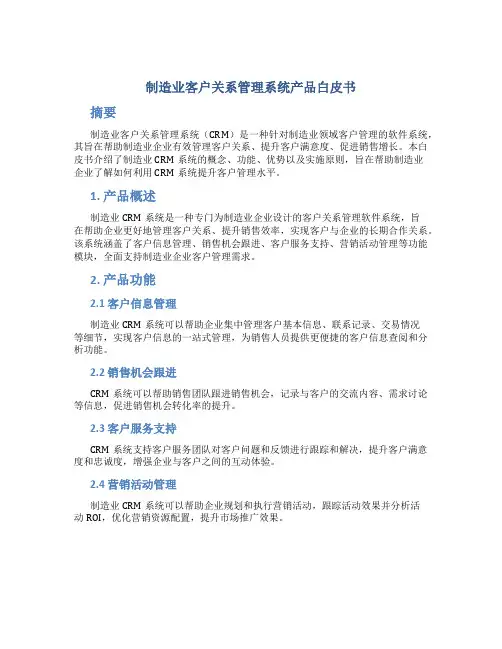
制造业客户关系管理系统产品白皮书摘要制造业客户关系管理系统(CRM)是一种针对制造业领域客户管理的软件系统,其旨在帮助制造业企业有效管理客户关系、提升客户满意度、促进销售增长。
本白皮书介绍了制造业CRM系统的概念、功能、优势以及实施原则,旨在帮助制造业企业了解如何利用CRM系统提升客户管理水平。
1. 产品概述制造业CRM系统是一种专门为制造业企业设计的客户关系管理软件系统,旨在帮助企业更好地管理客户关系、提升销售效率,实现客户与企业的长期合作关系。
该系统涵盖了客户信息管理、销售机会跟进、客户服务支持、营销活动管理等功能模块,全面支持制造业企业客户管理需求。
2. 产品功能2.1 客户信息管理制造业CRM系统可以帮助企业集中管理客户基本信息、联系记录、交易情况等细节,实现客户信息的一站式管理,为销售人员提供更便捷的客户信息查阅和分析功能。
2.2 销售机会跟进CRM系统可以帮助销售团队跟进销售机会,记录与客户的交流内容、需求讨论等信息,促进销售机会转化率的提升。
2.3 客户服务支持CRM系统支持客户服务团队对客户问题和反馈进行跟踪和解决,提升客户满意度和忠诚度,增强企业与客户之间的互动体验。
2.4 营销活动管理制造业CRM系统可以帮助企业规划和执行营销活动,跟踪活动效果并分析活动ROI,优化营销资源配置,提升市场推广效果。
3. 产品优势3.1 提升销售效率通过CRM系统的销售机会跟进和客户信息管理功能,企业销售团队可以更高效地管理客户信息、跟进销售机会,从而提升销售效率和转化率。
3.2 提升客户满意度CRM系统的客户服务支持功能可以帮助企业更及时地响应客户问题和反馈,提升客户满意度并建立长期稳定的客户关系。
3.3 促进团队协作CRM系统可以实现销售团队与客户服务团队之间的协作和信息共享,促进内部团队之间的协同工作,从而提升团队整体绩效。
4. 实施原则4.1 用户培训在CRM系统实施过程中,需要给企业员工提供系统培训,使其能充分了解系统功能和操作流程,提升系统使用效率。


客户关系管理(理念、技术、应用和未来)目录第一章客户关系管理背景 (1)第二章客户关系管理是什么 (3)一客户关系管理的产生 (3)1.需求的拉动 (3)2.技术的推动 (5)3.管理理念的更新 (6)二客户关系管理在技术上的实现 (6)1.销售 (6)2.营销 (7)3.客户服务与支持 (8)4.计算机、电话、网络的集成 (8)三客户关系管理能为企业带来的价值 (8)四对客户关系的理解 (9)第三章如何进行客户关系管理 (11)一管理:永恒的话题 (11)1.在管理方面要做哪些切实的工作 (11)2.管理的改进方面 (13)二实现CRM的关键成功因素 (13)第四章CRM系统的典型功能 (16)第五章CRM的未来之路 (19)第一章客户关系管理背景十几年市场竞争的磨练,尤其是中国加入了WTO,竞争的压力使得中国的企业对于可以提高企业竞争力的各种营销方法和管理方式表现出巨大的热情和尝试的兴趣。
对于20世纪80年代的MRPⅡ、90年代的ERP以及近来的CRM,不管IT厂商给这些企业管理方法和软件冠以什么样的名字,考察一种耗资巨大,涉及部门、人员众多的管理软件是否能够对企业的经营和竞争力带来好处,必须先搞清楚管理软件所包含的管理思想。
在早期,企业面对的是一个需求巨大,而供给不足的卖方市场,提高产品产量很自然成为管理的中心,企业管理基本是产值的管理。
企业不断努力的结果是生产效率不断发展,产品很快变得非常丰富,导致市场上产品销售的激烈竞争,于是销售中心论随之而起。
为了提高销售额,就必须在内部采取严格的质量管理,外部强化推销观念。
但是质量竞争的结果是产品成本越来越高,销售竞争的发展使得费用越来越高,这就使得企业的销售额不断提高,但是利润不断下降,于是作为销售额中心论的修正版本——利润中心论登上企业管理的舞台,企业管理的目标放在了以利润为中心的成本管理上。
但是,成本是不可能无限压缩的,当在一定的质量前提下成本的压缩已经到了极限,而企业利润要求仍然无法得到满足的时候,成本再压缩必然会带来产品质量的下降或者说提供给客户的价值降低。

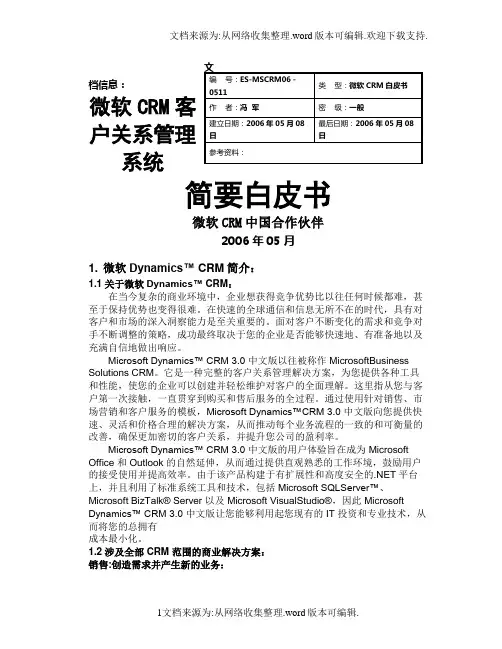
档信息:微软CRM客户关系管理系统简要白皮书微软CRM中国合作伙伴2006年05月1. 微软Dynamics™ CRM简介:1.1关于微软Dynamics™ CRM:在当今复杂的商业环境中,企业想获得竞争优势比以往任何时候都难,甚至于保持优势也变得很难。
在快速的全球通信和信息无所不在的时代,具有对客户和市场的深入洞察能力是至关重要的。
面对客户不断变化的需求和竞争对手不断调整的策略,成功最终取决于您的企业是否能够快速地、有准备地以及充满自信地做出响应。
Microsoft Dynamics™ CRM 3.0 中文版以往被称作 MicrosoftBusiness Solutions CRM。
它是一种完整的客户关系管理解决方案,为您提供各种工具和性能,使您的企业可以创建并轻松维护对客户的全面理解。
这里指从您与客户第一次接触,一直贯穿到购买和售后服务的全过程。
通过使用针对销售、市场营销和客户服务的模板,Microsoft Dynamics™CRM 3.0 中文版向您提供快速、灵活和价格合理的解决方案,从而推动每个业务流程的一致的和可衡量的改善,确保更加密切的客户关系,并提升您公司的盈利率。
Microsoft Dynamics™ CRM 3.0 中文版的用户体验旨在成为 Microsoft Office 和 Outlook 的自然延伸,从而通过提供直观熟悉的工作环境,鼓励用户的接受使用并提高效率。
由于该产品构建于有扩展性和高度安全的.NET平台上,并且利用了标准系统工具和技术,包括 Microsof t SQLServer™、Microsoft BizTalk® Server 以及 Microsoft VisualStudio®,因此 Microsoft Dynamics™ CRM 3.0 中文版让您能够利用起您现有的 IT 投资和专业技术,从而将您的总拥有成本最小化。
1.2涉及全部 CRM 范围的商业解决方案:销售:创造需求并产生新的业务:无论您的销售流程多复杂,Microsoft Dynamics™ CRM 3.0中文版向您提供易于使用的特性和功能,从而帮助您的销售和营销人员更好地寻找新客户、管理市场活动和推动销售活动。
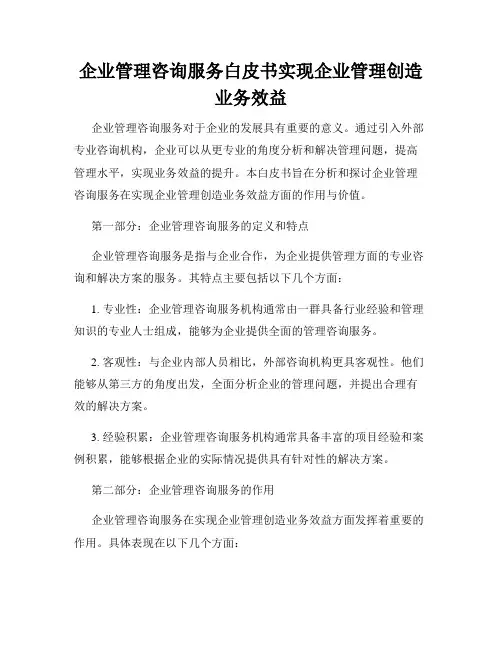
企业管理咨询服务白皮书实现企业管理创造业务效益企业管理咨询服务对于企业的发展具有重要的意义。
通过引入外部专业咨询机构,企业可以从更专业的角度分析和解决管理问题,提高管理水平,实现业务效益的提升。
本白皮书旨在分析和探讨企业管理咨询服务在实现企业管理创造业务效益方面的作用与价值。
第一部分:企业管理咨询服务的定义和特点企业管理咨询服务是指与企业合作,为企业提供管理方面的专业咨询和解决方案的服务。
其特点主要包括以下几个方面:1. 专业性:企业管理咨询服务机构通常由一群具备行业经验和管理知识的专业人士组成,能够为企业提供全面的管理咨询服务。
2. 客观性:与企业内部人员相比,外部咨询机构更具客观性。
他们能够从第三方的角度出发,全面分析企业的管理问题,并提出合理有效的解决方案。
3. 经验积累:企业管理咨询服务机构通常具备丰富的项目经验和案例积累,能够根据企业的实际情况提供具有针对性的解决方案。
第二部分:企业管理咨询服务的作用企业管理咨询服务在实现企业管理创造业务效益方面发挥着重要的作用。
具体表现在以下几个方面:1. 挖掘潜能:企业管理咨询服务能够通过分析企业的内外部环境,帮助企业发现自身的潜能,并提供相应的战略建议和实施方案,从而实现业务效益的提升。
2. 优化流程:企业管理咨询服务能够从流程优化的角度出发,帮助企业识别并改进存在的问题和瓶颈,提高各个环节的效率和产出,从而提高业务效益。
3. 引入新思路:外部咨询机构通常能够带来新的思路和方法。
通过与企业合作,他们能够为企业带来新的管理理念和方式,帮助企业创造更大的业务效益。
第三部分:企业管理咨询服务的应用案例1. 战略规划:某咨询机构协助一家电子产品企业进行战略规划,通过市场调研和竞争对手分析,为企业提供了新的市场定位和产品策略,并通过组织架构调整和资源配置优化来实现效益的提升。
2. 流程改进:某咨询机构协助一家制造企业进行流程改进,通过价值链分析和精益生产方法,帮助企业降低生产成本,提高生产效率,从而提升业务效益。
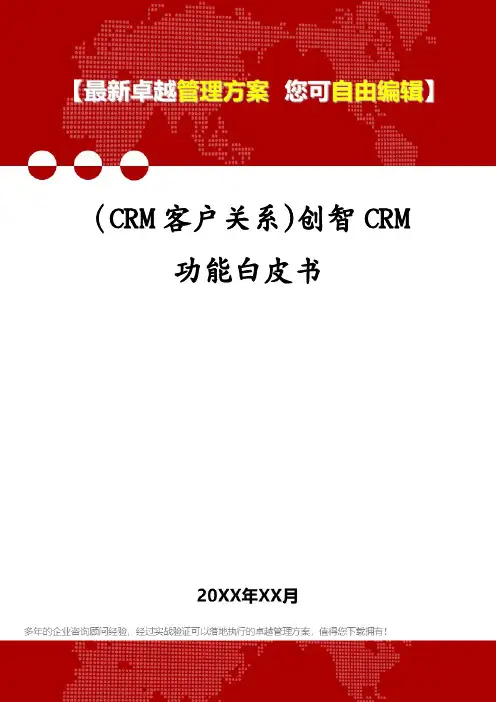
(CRM客户关系)创智CRM功能白皮书功能白皮书创智信息科技股份有限公司CRM事业部目录1POWERCRM功能概述42POWERCRM主要组成部分52.1P OWER CRM FOR S ALES52.1.1客户与联系人管理52.1.2销售机会管理52.1.3待办事宜与工作流52.1.4产品配置与报价62.1.5销售渠道管理62.1.6销售合同管理62.1.7网上订购62.1.8销售预测与报表功能72.1.9竞争对手跟踪72.2P OWER CRM FOR S ERVICE82.2.1客户和联系人信息82.2.2统一标准答案与解决方案库管理82.2.3服务跟踪与外勤服务82.2.4服务订单92.2.5产品维修92.2.6服务条款、担保书以及服务合同管理9 2.2.7待办事宜与工作流程102.2.8产品投诉跟踪102.2.9客户建议与提案102.2.10Web 资料库与客户自助102.2.11服务分析与报表102.3P OWER CRM FOR M ARKETING112.3.1市场预算和收入跟踪管理112.3.2市场活动管理112.3.3活动反响跟踪112.3.4促销内容管理122.3.5市场宣传资料122.3.6工作流自动化122.3.7任务管理122.3.8市场衡量指标122.3.9时间表管理122.3.10电话促销管理132.3.11邮件促销管理132.3.12Web促销管理132.4P OWER CRM FOR E_BUSINESS142.4.1网上定单142.4.2渠道关系管理142.4.3WEB资料库与自助服务142.4.4Email中心152.4.5WEB CallCenter152.4.6Up-Selling & Cross-Selling152.5P OWER CRM FOR P LAT F ORM152.5.1组织结构与人员管理152.5.2权限管理162.5.3工作流管理162.5.4系统配置162.5.5系统外部接口17PowerCRM∞功能白皮书1PowerCRM∞功能概述PowerCRM∞是一整套旨在改善与提升客户与企业之间关系的管理软件,它实施于企业的市场营销、销售、客户服务等与客户相关的领域。
Microsoft®商业解决方案▪M i c r o s o f t C R M微软客户关系管理解决方案—Building Profitable Customer Relationships2009.3Building Profitable Customer Relationships with Microsoft CRM目录1.公司介绍...................................................................................... 错误!未定义书签。
1.1微软公司............................................................................................... 错误!未定义书签。
1.2 微软CRM竞争优势 ............................................................................. 错误!未定义书签。
▪ 2. 微软CRM概述....................................... 错误!未定义书签。
2.1 微软CRM概述 ................................................................................... 错误!未定义书签。
2.2 微软CRM 的发展 ............................................................................... 错误!未定义书签。
2.3 市场定位............................................................................................. 错误!未定义书签。
用友TurboCRM产品白皮书本文版权归用友软件股份有限公司所有。
未经书面同意,不得以任何方式抄袭、节录或翻印。
用友软件股份有限公司CRM事业部用友TurboCRM产品白皮书第1 页共62 页用友软件股份有限公司CRM事业部用友TurboCRM产品白皮书用友软件股份有限公司CRM事业部第2 页共62 页用友TurboCRM产品白皮书第3 页共62 页用友软件股份有限公司CRM事业部用友TurboCRM产品白皮书用友软件股份有限公司CRM事业部第4 页共62 页用友TurboCRM产品白皮书第5 页共62 页用友软件股份有限公司CRM事业部用友TurboCRM产品白皮书用友软件股份有限公司CRM事业部第6 页共62 页用友TurboCRM产品白皮书第7 页共62 页用友软件股份有限公司CRM事业部用友TurboCRM产品白皮书用友软件股份有限公司CRM事业部第8 页共62 页用友TurboCRM产品白皮书第9 页共62 页用友软件股份有限公司CRM事业部用友 TurboCRM 产品白皮书第二篇 用友 TurboCRM 应用流程及应用环境用友 TurboCRM 客户关系管理系统是一个以客户为中心,通过引入数据权限和功能权 限对不同业务结构或区域结构下的各个部门及员工进行权限划分,以全方位的接触实现市 场、销售、服务等协同工作的管理平台。
通过管理客户、潜在客户、员工、产品、竞争对手 等,实现企业业务工作的全面管理,并能规范业务流程,提高市场营销能力和服务质量,准 确分析决策,达到全面提升企业核心竞争力的目的。
2.1 用友 TurboCRM 应用流程2.1.1 用友 TurboCRM 数据流程图系 统 业 务 数 据 流 业务信息库 市 场 部 门 任务管理 市场活动 市场任务 工作进程管理 市场工作进程 其他客 户 信 息销售机会销售任务销售工作进程电子促销报价单 系 统 工 作 流 伙 伴 信 息 执行计划 产 品 信 息 销 售 部 门销售订单 客户挖掘 退货单订单执行电子催收对 手 信 息客户反馈 服 务 部 门服务任务服务工作进程生成关怀建议特殊关怀关怀建议管理【图 2-1】用友软件股份有限公司 CRM 事业部第 10 页共 62 页用友 TurboCRM 产品白皮书2.1.2 针对人员角色的应用流程1. 用友 TurboCRM 系统针对企业决策者的应用:【图 2-2】 如【图 2-2】所示,对于企业决策者来说,最关心的是部门协调、分析决策等问题。
雅座CRM标准版2.0产品白皮书版本:V1.0©2011 雅座在线(北京)科技发展有限公司前言根据中烹协最新数据统计,中国的餐饮网点累计超过400万家,2011年经营总收入将突破2万亿元大关,增长速度远高于其他行业。
然而,在市场不断膨胀的背后,餐饮企业的各种管理问题也随之显现。
那么餐饮企业具体存在哪些问题呢?·对顾客管理的认识不够充分,未给予重视;·如何发展新客户,并获取有用的客户资料信息;·营销手段较为单一,缺乏针对性,不能差异化的提高顾客满意度和忠诚度;·难以判断具体的目标客户和价值客户群,不知道目标客户在哪里;·如何安全、有效开拓储值卡的融资渠道;·如何运作已有顾客资源,提升店面流水;·开展客户管理,但技术瓶颈难以突破;·如何提升企业在顾客心中的美誉度,深化品牌形象。
为了满足餐饮企业管理者解决现存的这些问题,智能化的客户关系管理软件已经成为餐饮企业的首选,依靠其科学的算法,精准的分析使其成为提升利润与竞争力的有力工具。
有着多年餐饮业客户关系管理与设计经验的“雅座”,紧随市场的脚步,以超前的理念、先进的算法和完善的功能,推出了CRM系列产品,助力餐饮企业在竞争中脱颖而出。
我们的理念※掌握消费者的消费行为信息,通过大量筛选和分析,组织有针对性的活动,全面提升流水和利润;※通过完善的客户管理工作,不仅可以充分挖掘现有客户的潜在价值,还能延长客户生命周期;※深化品牌形象和提升客户满意度来达到吸引更多新客户的目的。
1)消费者营销力模型雅座通过多年的对餐饮业客户关系管理与设计经验,自主研发出一套独特的帮助餐饮企业对客户进行全生命周期管理的消费者影响力模型。
该模型通过分析消费者的心理与行为,挖掘出不同程度忠诚度的客户对于企业影响力不同价值,从而将客户按照忠诚度分为忠诚客户,散客,过客,潜客,盲客和无关客。
该消费者影响力模型覆盖所有有机会给企业带来利润的人群,并通过对该模型客户信息的分析,管理与营销,最大程度的加速企业盈利,该影响力模型已经过早期产品的验证,成功的给客户带来了利润的提升及企业资源的优化。
浙大网新银行业CRM产品白皮书版权声明浙大网新科技股份有限公司拥有本产品及相关文档的全部版权。
未经本公司书面许可,任何单位及个人不得以任何方式或理由对本产品的任何部分进行复制、抄录、传播或将技术文档翻译成他国语言,并不得与其它产品捆绑销售。
信息更新本产品最新版本、升级信息以及相关技术文档将在浙大网新科技股份有限公司的/网站上及时推出,敬请留意。
信息反馈浙大网新科技股份有限公司欢迎您通过尽可能多的渠道向我们提供尽可能多的信息,您的意见和问题都会得到我们的重视和妥善处理,请将反馈信息投递到下述地址:浙大网新科技股份有限公司地址:杭州市天目山路176号西湖数源软件园8楼5层电话:(0571)88279689传真:(0571)88279657邮编: 310007E-mail: Joeli@目 录1. 银行业客户关系管理概述 (4)2. 网新CRM系统结构 (7)2.1. 网新CRM系统构成 (7)2.2. 网新CRM系统逻辑结构 (8)3. 网新CRM产品特点 (9)3.1. 业务特点 (9)3.1.1. 大型的营销服务平台和标准化业务流程的建立 (9)3.1.2. 整合客户资源,建立360°客户全景视图以及完整的客户类别体系 . 93.1.3. 客户、客户经理关系的认定与客户群体关系树的建立 (10)3.1.4. 结合银行全员营销策略,挖掘潜在客户价值 (10)3.1.5. 不同渠道的推送服务,提高客户的满意度 (11)3.1.6. 提高营销管理的科学化和高效性 (11)3.1.7. 方便的工作流管理与监控 (11)3.1.8. 运营与分析的闭环互动 (12)3.2. 技术特点 (13)3.2.1. 先进的CRM平台体系构建、高效、低成本 (13)3.2.2. 业务数据集中整合实现个性化营销功能 (13)3.2.3. 灵活的系统接入方式 (13)3.2.4. 安全的数据保障 (13)3.2.5. 实现银行多级网状组织架构的管理 (14)4. 网新银行CRM产品功能 (15)4.1. 信息管理模块 (15)4.1.1. 客户统一视图 (15)4.1.2. 客户管理 (16)4.1.3. 金融产品管理 (16)4.1.4. 客户经理工作平台 (16)4.1.5. 用户与机构管理 (17)4.2. 营销管理模块 (18)4.2.1. 自动化的营销流程 (18)4.2.2. 客户细分与筛选 (19)4.2.3. 营销活动管理 (19)4.2.4. 潜在客户管理 (20)4.2.5. 销售过程管理 (21)4.2.6. 客户服务 (21)4.3. 综合分析模块 (24)4.3.1. 综合客户分析 (24)4.3.2. 营销效果的考核 (24)4.4. 交互服务模块 (26)5. 网新银行业CRM产品成功案例 (27)6. 技术支持与服务 (29)6.1. 服务宗旨 (29)6.2. 服务体制 (29)1. 银行业客户关系管理概述金融行业是近几年中国发展速度最快的行业之一。
SynleadCRM客户关系管理系统(企业版5.0)产品白皮书北京起点信息技术有限公司2006年1月目录第一章中端CRM应用 (1)1. 让您的客户参与运转CRM (1)1.1 客户参与哪些运转 (1)举例1:推动网络教育培训-客户自助学习,企业答疑辅导 (2)举例2:推动CRM市场营销、销售自动化-在线提交需求,自助订单 (2)举例3:推动售后服务自动化-在线提交服务请求,企业反馈解决方案 (3)1.2 企业从客户参与中获得什么 (3)受益1:无事不登三宝殿-客户参与通常携带潜在、明确需求或问题 (3)受益2:企业也走近客户-获得更多零距离观察、了解、推动客户的机会 (3)2. 市场营销自动化管理 (4)2.1 营销战役 (4)战役负责人下达清晰计划、精确目标,对战役骨干人员准确授权 (4)战役中/后,可对执行目标成效进行定量统计、比对、分析 (5)2.2 营销线索 (5)联系人@单位,是最起码的线索条件 (5)每个线索可分发给一或多名业务员辨识、跟踪 (5)可批量移交、批量自动分发线索,也可批量收回分发出去的线索 (6)有质量的线索及时进行机会、联系人、单位转化 (6)2.3 营销规则 (7)线索自动分发规则 (7)网站线索向CRM自动推送令牌规则 (7)网站与CRM接口参数规则 (8)2.4 网站会员 (8)用CRM系统管理网站会员更有意义 (8)会员自助维护帐户,企业监控管理 (9)3. 服务自动化管理 (9)3.1 您售出的产品转化为客户资产和权益 (10)3.2 高效流程取决于各环节精确管理 (10)销售组织向客服组织及时递进成交的客户资源 (11)其它环节精确管理对高效自动化流程的影响 (11)3.3 客户满意度衡量与客户关键体验、感受 (11)客户得不到雪中送炭的愤怒和无奈 (12)提供一个能够倾听客户真实体验和感受的窗口 (12)4. 销售自动化管理 (13)4.1销售自动化管理不只是自动生成、输出几份报价单 (13)各业务环节事务处理自动化 (13)业务流程递进与分工协作自动化 (14)统计、分析、预测自动化 (14)4.2现代商战背后的CRM信息战和自动化指挥系统 (14)以项目式精确作业为目标 (14)以扁平化功能团队为模块动态调员协同会战 (15)高管或资深专家可以指挥到一线单人单员 (15)4.3 销售英雄将来自熟练驾驭CRM自动化协作的那些人 (16)个人关系越来越挡不住企业推行的近距离、零距离客户关系管理 (16)时势造英雄,至少要搭上每个时代的末班车 (16)5. 重新审视360°客户关系管理,效率与效能 (17)5.1 CRM软件本身必须具备的商务可视化、可切片、可旋转 (17)CRM商务思想可视化与商业模式可塑化 (17)CRM可切片、可旋转的360°商务时空穿梭 (18)5.2 效率并非全部,产出效能也要获得预期收益 (18)6. 数据挖掘分析,客户价值金字塔,效能与负荷驾驶舱 (19)6.1 数据挖掘分析,多角度/多尺度/多方法统计、分析、预测 (19)预置模型的、开放的、可修改的、可新增的XSL报表/图表模板 (20)可在线提取CSV应用数据,用Excel自由进行数据/图表透视分析 (20)6.2 客户价值金字塔,效能与负荷驾驶舱 (20)客户价值金字塔 (21)效能与负荷驾驶舱 (21)第二章技术特点、应用模式和安全性 (22)1. SynleadCRM企业版5.0技术特点 (22)1.1 技术架构 (22)B/S架构 (22)B/S+C/S双架构 (22)1.2 率先采用新一代XML、XSL标准和DHTML动态组件技术 (23)采用新一代XML业界统一标准 (23)采用新一代XSL业界统一标准 (23)采用DHTML组件,丰富动态表现和动态行为 (24)2. SynleadCRM企业版5.0应用模式 (25)2.1 托管服务器模式(主机托管): (25)2.2 总部服务器模式(服务器放在总部办公场所): (26)2.3 分布模式(网站服务器在IDC,CRM服务器在总部) (26)3. SynleadCRM企业版5.0安全性 (27)3.1 采用Windows帐户认证 (27)3.2 采用Windows集成安全性访问数据库 (27)3.3 关键、敏感应用程序被编译封装为组件 (28)3.4 可进一步设立防火墙,增强安全警戒 (28)第三章软件产品应用子系统简介 (29)1. 业务管理子系统 (29)1.1 首页(Home) (29)1.2 单位管理(Accounts Management) (30)1.3 联系人管理(Contacts Management) (30)1.4 会员管理(Member Management) (31)1.5 机会管理(Opportunities Management) (31)1.6 服务请求管理(Service Requests Management) (31)1.7 营销战役管理(Marketing Campaigns Management) (32)1.8 线索管理(Leads Management) (33)1.9 任务管理(Tasks Management) (33)1.10 日历管理(Calendar Management) (33)1.11 报价单管理(Quotes Management) (34)1.12 服务合约管理(Agreements Management) (34)1.13 合同管理(Contracts Management) (35)1.14 提议管理(Proposals Management) (35)1.15 价格管理(Prices Management) (35)1.16 产品管理(Products Management) (36)1.17 存货管理(Inventories Management) (36)1.18 客户资产管理(Assets Management) (36)1.19 知识库管理(Solutions Management) (37)1.20 类别管理(Categories Management) (37)1.21 竞争对手管理(Competitors Management) (37)1.22 营销规则管理(Marketing Rules Management) (38)1.23 自动信函管理(Correspondence Management) (38)1.24 费用管理(Expenses Management) (39)1.25 销售预测、客户金字塔、企业驾驶舱(Deep Data Mining) (39)1.26 回收站管理(Recycle Bin Management) (40)1.27 本公司管理(Company Information Management) (40)2. 数据挖掘分析子系统 (41)2.1 报表 (41)2.2 图表 (42)2.3 集成Excel的数据、图表透视分析 (43)3. 后台管理子系统 (43)3.1 用户管理 (44)3.2 团队管理 (44)3.3 角色管理 (45)3.4 审核管理 (45)3.5权限冲突管理 (45)3.6 系统表管理 (45)3.7 公司信息管理 (46)4. 个性化管理与自动化代理子系统 (46)4.1 个性化管理 (46)4.2 自动化代理 (50)第四章 CRM知识和方法论 (53)1. CRM与ISO9000 (53)2. CRM客户关系管理“做什么” (54)2.1 了解客户行为、表现和价值规律 (54)2.2 为了提高收益,企业应该“做什么” (55)3. CRM客户关系管理“怎样做得更好” (56)3.1 多维管理要素转化为三维管理及业务流程动态递进的方法 (56)3.2 让管理变得更简单 (58)3.3 更多精确管理 (59)基于客户的会计核算 (59)对定性描述进行量化 (60)定期提取重要业务分析应用数据样本 (60)4. CRM应用系统应具备扩展能力 (60)4.1 内置扩展 (60)客户化报表举例(Report) (61)客户化Word文档举例 (61)客户化Excel分析举例 (62)4.2 在线、离线办公扩展 (63)4.3 第三方应用系统扩展 (64)第五章关于北京起点信息技术有限公司 (65)本白皮书或软件的内容若有变动,恕不另行通知。
微创客户关系管理XP白 皮 书2002年7月上海微创软件有限公司目 录1CRM 与CRM软件 (6)1.1 什么是CRM? (6)1.2CRM能为您带来什么? (6)2微创CRM XP简介 (8)2.1 微创CRM XP的五大功能特点 (9)2.1.1 集中管理客户信息和销售信息 (9)2.1.2 辅助销售过程 (10)2.1.3 多角度多维度的销售决策分析 (11)2.1.4 随时随地实现管理的离线功能 (12)2.1.5 灵活的自定制性 (13)2.2 微创CRM XP与同类产品的比较 (14)3 微创CRM XP 功能模块 (16)3.1 系统的登录和退出 (16)3.1.1 登录系统 (16)3.1.2 设置服务器地址 (17)3.1.3 进行脱机操作 (17)3.1.4 注销当前用户 (17)3.1.5 退出系统 (18)3.2 系统首页 (18)3.3 地址簿 (19)3.4 帐户管理 (20)3.4.1 记录和维护帐户的基本信息。
(20)3.4.2 帐户的共享管理 (21)3.4.3 帐户关联信息的管理 (22)3.4.4 关心目标客户――帐户的查询 (23)3.5 联系人管理 (25)3.5.1 与帐户相关联的联系人的基本信息 (26)3.5.2 查询联系人 (26)3.6 行动管理 (27)3.6.1 行动基本信息的管理 (27)3.6.2 对某销售活动进行查询 (28)3.7 机会管理 (28)3.7.1 机会基本信息的管理 (29)3.7.2 机会的关闭和激活 (29)3.7.3 对机会进行查询 (30)3.8 费用管理 (30)3.8.1 查看费用信息 (31)3.8.2 审核费用 (31)3.8.3 费用的查询 (32)3.9 订单管理 (32)3.9.1 基本信息 (33)3.9.2 为订单添加产品 (33)3.9.3 添加交货信息 (34)3.9.4 添加收款信息 (34)3.9.5 对订单的查询 (34)3.10 产品管理 (35)3.10.1 查看产品的基本信息 (35)3.10.2 查看产品的相关信息 (35)3.10.3 对产品进行查询 (35)3.11 交货确认管理 (36)3.12 收款确认管理 (36)3.13 库存管理 (36)3.13.1 查看仓库产品信息 (36)3.13.2 入库操作 (36)3.13.3 出库操作 (36)3.13.4 转仓操作 (37)3.14 销售定额分配和销售额预测 (37)3.15 工具菜单管理 (37)3.15.1 强大的同步和刷新功能 (37)3.15.2 修改密码 (38)3.15.3 系统选项 (38)3.15.4 供应商名录和渠道商名录 (39)3.15.5 提醒窗口 (39)3.16 报表分析 (40)3.16.1 功能介绍 (40)3.16.2 了解不同产品的销售情况 (40)3.16.3 了解销售对象分布的地域 (41)3.16.4 了解各部门的销售业绩 (41)3.16.5 了解不同时期的销售趋势 (41)3.16.6 分析帐户 (41)3.16.7 分析机会的价值 (41)3.16.8 销售配额分析 (42)3.16.9 保存自定义报表 (42)4 微创CRM XP的激活 (42)5 微创CRM XP空白报表 (43)6 微创CRM XP导出模板 (43)7 微创CRM XP数据管理 (45)8 微创CRM XP系统设置 (45)8.1 公司信息 (45)8.2 全局设置 (46)8.3 组织结构 (47)8.4 用户信息 (48)8.4.1 密码管理 (49)8.4.2 公司组织结构管理 (49)8.4.3 人员组织结构管理 (49)8.4.4 权限管理 (50)8.4.5 待聘岗位管理 (50)8.5 产品信息 (50)8.5.1 产品基本信息 (50)8.5.2 产品信息的导入 (51)8.6 仓库、渠道商、供应商信息 (51)8.7 自定义字段 (52)8.8 客户地域设置 (53)8.9 设置菜单 (53)8.9.1 用户组设置 (53)8.9.2 订单审核组设置 (54)8.9.3 销售阶段设置 (54)8.9.4 送货单位设置 (55)8.9.5 设置安全策略 (55)8.9.6 订单审核流程设置 (55)8.9.7 帐户转移 (55)8.10 操作菜单 (56)8.10.1 恢复已删除的记录 (56)8.10.2 进行系统完整性检查 (56)1CRM 与CRM软件1.1 什么是CRM?客户,作为一种宝贵的资源被越来越多的企业纳入到经营发展中来。
Analytical Customer Relationship ManagementA Whitepaper from Sybase,Inc.Frank TeklitzSenior ManagerRobert L. McCarthySenior Marketing ManagerTable of Contents Introduction (2)Challenges for Customer-Oriented and Market-Oriented Companies (4)The New Approach for Business Intelligence (4)Analytical CRM Defined (5)A Recipe for Closed-Loop Business Intelligence (6)Customer Analysis (6)Getting the Right Information — A Customer Analysis Example (7)Market Segmentation (7)A Market Segmentation Example (7)One-to-One Marketing (8)A Treatment Strategy Example (8)Event Modeling (8)An Event Modeling Example (9)The Ultimate Refinement:Y our Bottom Line (10)Challenges in Delivering Analytical CRM (11)Typical Data Warehouse Project Development (11)Benefits of Using a Packaged Data Warehouse Infrastructure (12)Introducing the Sybase Industry Warehouse Studio™ (14)Sybase Delivers the Right Solution Today (15)Industry-Focused Warehouse Studios (15)Industry Warehouse Studio Packaged Application Reports (15)Campaign Analysis (16)Customer Profile Analysis (17)Sales Analysis (18)Loyalty Analysis (19)Customer Care Analysis (20)Getting Results Today (21)Appendix A:Sybase Industry Warehouse Studio Components (22)Industry Data Models (Included with IWS) (22)Packaged Application Reports (Included with IWS) (22)Warehouse Architect (Included with IWS) (22)Warehouse Control Center (Included with IWS) (23)Methodology and Project Plans (Included with IWS) (23)Database Independence (Standard Feature of IWS) (24)PowerStage (Optional Feature of IWS) (24)IntroductionThe need to find new sources of revenue is a fundamental requirement for business growth.Typically it means reaching current customers and prospects in ways that will encouragethem to do more business with you.From your customer’s perspective,there are so manychoices in products,services,delivery,and packaging that your efforts to sell them moreproducts can result in an onslaught of information—often confusing information.And fromyour business’s perspective,there are so many “touch points”where information is exchangedbetween you and your prospective or current customers such as customer support centers,direct mail,telesales,direct sales,e-commerce,and the Web,that it is difficult to determinewhich methods deliver the best results.Over the last 30 years,we have moved from a mass-market culture of relatively few productswith a limited number of options to a dynamic market where many products may be easilycustomized to fit the specific requirements of an individual customer.For example,not thatlong ago,banking customers had relatively few product choices—savings accounts,checking,CDs,and fixed rate mortgages.T oday,every bank provides a variety of investment choices,loan types with fixed and variable interest rates,direct deposit accounts,electronic bankingoptions,leases,credit cards,and more.Banks even offer insurance and brokerage services.Prospective and current customers are,at times,overwhelmed with invitations from theirexisting suppliers to increase their use of products and services.At the same time,they arerepeatedly courted (and provided incentives) by their supplier’s competition to move theirbusiness for a “better deal.”In the past,many organizations depended on personalized ser-vice to develop and maintain the loyalty of their customers.As the customers’relationshipwith their supplier has become more electronic,the traditional source of customer loyalty—personal service—has been impacted.The one-to-one contact with an organization nowoccurs most often by telephone or on the Internet.Customers order products by fax,e-mail,over the Internet,and computer to computer viaelectronic data interchange.They also interact with a telesales operator or sometimes even anautomated attendant.Customer service is quite often conducted by Internet,e-mail,or by tele-phone.The only constant in the relationship contact is the customer.While this may facilitatethe process and make the sales and service aspects of doing business more cost-effective,it canlead to a more impersonal relationship between the customer and the organization.Thisadversely affects the relationship from both the customer’s and the supplier’s point of view.First of all,if you’re the customer,you want to be remembered! Doesn’t everyone? Remember-ing your purchase patterns to remind you when it’s time to restock is important.So ismonitoring them for aberrations to detect and uncover fraud.You want your recent contactswith the supplier recalled so you don’t have to repeat your interests over and over to eachnew contact.Many of us have experienced this kind of“remembering”in dealing withInternet-based firms like those who sell books.By knowing your buying pattern,the suppliercan make reasonable recommendations on new books for you to purchase.Andby “remembering”your delivery and billing information,you facilitate and expedite theplacement of an order.Today’s consumers are both educated and demanding.They demand that any interactionwith their suppliers be quick and efficient.With the increasing impact of the Internet andtelesales operations,customers can shop for alternatives without leaving their chairs.2“Companies are realizing thatthe keys to long-term,sustain-able revenues and profits areidentifying,acquiring,and retain-ing profitable customers.Unfortunately,most companiesdon’t know which customers areprofitable and which are not.They also don’t know which cus-tomers are likely to defect andwhich are likely to respond toparticular offers and products.Most importantly,few companiescan identify those customers orprospects that have the greatestpotential to become profitablecustomers over time,given theright marketing investment.”— Wayne W. EckersonSenior consultant/analystInformation AssetsPatricia Seybold Group 3Think of your own buying decisions.Have you ever made a purchase because:* One supplier had the item in stock and another did not?* One supplier could meet your specific needs promptly with just what you wanted? * One supplier was more responsive to your inquiries and “remembered”previous contacts?And this “memory”concerning customers is important to suppliers as well.Many organiza-tions have recognized this opportunity already.They have implemented operational customer relationship management (CRM) software such as call center technology for customer care or sales automation technology to improve their sales process.If used properly,these tools can personalize the process of sales and support more,addressing the customer’s needs in the “touch points”of sales and service.The supplier wants to leverage these tools to deepen their customer relationships —especially with those customers whom they regard as low-risk and highly profitable.CRM has too often been used as an opportunity for one-way communication.Put more crudely,cleverly targeted mailings and sophisticated profiling techniques may have helped the direct marketers increase their response rates.But,used in isolation,they will not,and cannot,deliver true customer relationship management.“The real benefits of CRM are located in the customization of service,not literature,”says Sean Kelly,Vice President,European Operations for Sybase,Inc.,and author of the first authoritative text on data warehousing,Data Warehousing —the route to mass customization.“Far too many organizations are focusing on CRM simply to up-sell or cross-sell their products and services without giving enough thought to how they will enhance their cus-tomer care strategy.By focusing exclusively on the sales opportunities that CRM presents,they ignore other forms of interaction such as the analysis of customer consumption patterns,levels of customer contact (including complaint procedures),and more effective analysis of customer profitability.”So how does a business in today’s world begin to understand who its low-risk,high-profit customers are? And even if it establishes who its best customers are,how can it leverage this to determine how to reach and keep customers whose demands are changing and whose attentions easily shift from one company to another within the marketplace?The early adopters of data warehousing understood the power of customer information—and the benefits to be gained from the business intelligence solutions needed to deliver that information.The data warehouse technology provides the location where data may be centralized,integrated,stored,and accessed.But without business intelligence,it may not be anizations that have had the expertise and the resources to implement a customer-focused data warehouse now are reaping the rewards of true CRM — simply by understanding what their customers want from them.This paper examines a new approach to implementing a Business Intelligence solution focused on the analytical aspects of CRM.This approach will help businesses better analyzetheir target markets.From there,they will gain the insight needed to formulate profitable strategies and tactics to reach their customers more effectively.It will provide an insight on how a customer-focused data warehouse can be implemented faster with fewer resources at the same time as it delivers reduced risk.Implemented effectively,Business Intelligence com-bines technology with business strategy to give your customers the services and products they want,thus better protecting them from being taken away by your competition.At the same time,Business Intelligence allows you to grow your business with new customers who share the profitable characteristics of your current customer base.Challenges for Customer-Oriented and Market-Oriented CompaniesCurrently,many customer-oriented and market-oriented companies evaluate theircustomers along demographic (age,sex,geography),lifestyle (buying habits,activities,andaffiliations),and family (household) groupings.With these database-marketing techniques,marketers use traditional methods such as direct mail to “touch”potential customers for newbusiness.For example,it is common to do mailings by specific groupings or segments for,let’s say,“all prospects 55 or older who play golf.”This kind of modeling yields virtually noinsight regarding the profit potential of this group or even if these prospects respond todirect mail.In fact,many questions are left unresolved by these kinds of traditional databasemarketing techniques.Among the questions are:• Increased Acquisition Costs.How do we reduce the cost of gaining a new customer,whichoften exceeds the profit that can be generated from that customer?• Increased Customer Service Costs.How do we move customers toward more cost-effectiveservice channels like the Web?• Inadequate Knowledge of the Customer.What are the customer’s service needs,profitperformance,and lifestyle choices?• Complex Customer Profitability Models.What are the right combinations of products,services,sales,and marketing support needed to drive profitable business?• Increased Account Churn.How can we retain customers and build loyalty?The New Approach for Business IntelligenceToday,with the advent of Business Intelligence applications and integrated supportingdata models,it is possible to deliver fine-tuned analyses of the needs of individual customers,based on buying habits,preferred marketing interactions,and lifestyle choices.This helpscreate more profitable and more personal business relationships that can drive every “touchpoint”in your organization,including customer service,telesales,direct sales,e-commerce,Web marketing,and business operations.For example,a business analyst can use the customer’s buying needs and preferences todeliver a specifically designed service package that addresses the customer’s business needsdirectly.This builds a stronger business relationship with that customer and provides thecompany with new revenue opportunities.At the same time,the marketing department notonly can evaluate direct marketing programs,but also can determine the optimal follow-upactivities for every customer based on the relevant customer segmentation combinations.Ideally,all this new customer intelligence enables you to direct your most profitablecustomers to your most experienced customer service or sales representatives.4Analytical CRM DefinedAnalytical CRM is the focused analysis of data created by the operational side of CRM and legacy applications for the purpose of business performance management.Analytical CRM is necessarily dependent on the existence of a data warehouse infrastructure that integrates CRM data and facilitates access to it.Analytical CRM,therefore,enables organizations to identify and balance needs,patterns,opportunities,risks,and costs associated with existing and potential customers to maximize the overall enterprise value.An integrated Analytical CRM solution addresses all of the following:• Customer Profiling (segmentation,risk,propensity)• Campaign Management (analysis of campaign effectiveness)• Customer Care (analysis of customer contacts and service)• Customer Loyalty (persistency,retention,churn)• Sales Analysis and Prospecting (sales by product,category,store,channel,customer acquisition,cross-sell,up-sell)5Getting the Right Information—A Customer Analysis ExampleThe information needed for customer analysis typically represents key “touch points”for customers (customer service,World Wide Web,automated teller machines),key revenue points (point of sales,e-commerce,order entry),and external data (demographics, lifestyle,householding).Before any analysis can begin,it is essential to know the information available,the quality of that information,and the level of integration and cleaning (extraction and transformation) needed to deliver a functional data warehouse.The emphasis here is on “functional”rather than “complete”because with any decision support system,including Business Intelligence systems,new sources of information are constantly being identified,cleaned,and added.Also, older information should continually be evaluated for relevance in light of current business and market demands.The key information often associated with the customer analysis phase includes customer service history,customer marketing history,sales and revenue by customer,and customer demographic and lifestyle data.These numerous sources of information must be integrated to create a complete view of the customer in the data warehouse.Once customer information is integrated to reflect product purchases,revenue,service history,demographics,and lifestyle information,it is now possible to rank customer behavior and profitability,and to develop scoring models that begin to predict future behavior.By maintaining a complete history of each customer’s revenue,cost, and utilization,it is possible to:• Determine customer profitability• Score customer receptiveness to different forms of marketing• Determine the number and type of products in use• Measure customer retention and determine degree of loyalty• Assess customer self-service patterns based on their activities recorded on your Web site.Market SegmentationWith a customer data warehouse in place,it is possible to perform sophisticated customer segmentations to analyze and target both strengths and weaknesses in your customer and prospect base.Some common market segmentation questions include:• Which customers buy product A but not product B?• Which customers respond directly to particular marketing programs?• Who are the most profitable customers?• Does our customer profitability vary according to geographic or demographic characteristics?A Market Segmentation ExampleAd-hoc analysis and data mining may be used to evaluate permutations and combinations of variables,allowing you to discover new ways to segment the customer base.For example, your data-mining tool of choice may discover that customers whose primary hobby is sailing have a high interest in vanity VISA cards.The data warehouse may also reveal that not only do these customers like vanity VISA cards,they also use the cards frequently.By doing ad-hoc queries against this customer group,you may discover that many of these sailing customers do not currently have boating loans with your bank.With additional analysis,you might discover that customers who did obtain loans responded well to direct telesales calls,but not to direct mail campaigns.Finally,you may determine whether your current sailing customers are “low maintenance”— i.e.,they use the Web for self-service needs.7This example illustrates the value of developing an integrated customer data warehouse forAnalytical CRM.With the right tools and information,it becomes possible to discover mar-ket segmentations that would not be visible with conventional data analysis techniques.One-to-One MarketingHaving discovered a number of potentially profitable market segments,it is now possibleto deliver tailored marketing campaigns for every “touch point”in the organization,fromtelemarketing to customer service designed for the specific needs of the customer segment.These end-to-end programs are often called “treatment strategies,”not unlike the treatmentstrategies of a medical doctor who uses “best practices”to deliver the most optimal,efficient,and complete patient care.A Treatment Strategy ExampleContinuing with the boating customer example,imagine that you develop a treatmentstrategy for your sailing customers to promote a new line of boat loans.As an incentive forthis promotion,you have decided to include a “no fee”direct deposit and VISA account forone year,using vanity cards in a choice of four nautical themes.Not only do you develop atelemarketing plan to reach customers with an interest in sailing,but you also create specialWeb pages and appropriate customer service scripts.Through this kind of detail-level analysis,you can put together similar treatment strategiesdesigned around the relationship needs of golfers,triathletes,and Home Network shoppers.Through your use of targeted marketing and execution,your company can make a significantand lucrative transition.Where you once promoted your products to customers who may nothave wanted them,you now can become a builder of specific customer relationship programsdesigned around the needs of your high-potential,high-profit customers.Event ModelingEvent modeling enables business organizations to deliver more accurate and successfulmarketing campaigns and treatment strategies.Event modeling takes advantage of statisticaltools to build models that “explain”the behavior of customers and predict the response ofcustomers and prospects to future marketing promotions.Event modeling enables you tounderstand which events in a customer’s life—birthdays,purchase of a new car or house,birth of a child—can lead to opportunities that add value with your products and services.These events,which can be ascribed to market segments,are also powerful tools to evaluatecustomer and prospect profitability.Event modeling seeks ways to reduce the number ofpromotions,manage the costs of business strategies,and increase the percentage responserates to promotions—all of which ultimately boost profits.Some typical questions addressed with predictive event modeling are:• Which customers by age segmentation are most likely to respond toa reduced price promotion?• How long after buying a new car (securing a car loan) are customers likelyto pursue a home mortgage?• Who is likely to buy only if contacted in person?• Is our marketing strategy for high-profit customers impacting profitability and retentionas predicted?The objective is to learn which of the possible variables most effectively predict customerresponse.Y ou then can identify customers or prospects with similar characteristics to target.In many cases,you can use the newfound knowledge about buyer characteristics to test8alternative treatment strategies.With further refinement,your treatment strategies can produce greater customer satisfaction with your message,service,and products—leadingto a higher response rate.An Event Modeling ExampleReturns and Early PredictionsTo continue with our boating example,imagine you are now three months into the boat loan promotion.Y our telesales campaign reached 10,000 customers and prospects,and generated a whopping 8% response rate of which 50% closed—that is,you acquire 400 new boat loans.The close rate was well within expectations,but the number of loans rejected was high.Of the 800 prospects who responded,300 were rejected mostly because of credit risk.Y our next step might be to model the sailing customers using a variety of modeling techniques—including regression,chaos classifiers,and neural networks—to determine what variables best predict the propensity for credit risk.These models would consider group and individual risk factors such as family income,home value,type of dwelling,age,number of children,and geography.Now,imagine your team has determined that the 300 rejected prospects had a high propensity to live in an apartment (30% of population),with an annual income under $35,000 and an average age of less than 27 years.The average size of the loan this segment requested was $23,000.On the other hand,your team determined that those prospects who did obtain a loan generally own a home (66% of population),earn $72,000 annually,and on average are 34 years old.The average loan approved for this segment was $37,000.Refining Treatment StrategiesY our next step is to do some quick ad-hoc analysis and,behold,you find that 70% of the rejected loans were for a first-time boat owner.This leads to a special treatment strategy that includes loans for used boats.Y ou modify your Web site to include a Web search window for used boats being sold in the area.Y ou also include a boat loan calculator to help first-time boaters determine the size of loan for which they can qualify.Y ou also can explore the key characteristics of those customers who qualified for loans greater than $50,000,$70,000,and $100,000.This leads to a three-segment treatment strategy. For medium-risk customers who make less than $35,000,you provide new and used boat loans.For customers making $35,000 to $100,000,the treatment strategy described earlier will be used.And for those prospects who make more than $100,000,you team up with a boat insurance company to offer $1,000 in free merchandise if they qualify for a loan and also purchase boat insurance.As part of the treatment strategy for your high-end prospects, you feed your prospect leads into the new sales force automation system.Your campaign management system then could automatically generate an e-mail to the field representative for all top-level prospects who respond to the telesales campaign.It would include all appro-priate customer information (name,address,birth date,secondary interests,and hobbies) needed to help close the deal.These refinements in the strategy lead to increased response and close rates for the most lucrative customers and increased profitability of the low-end segments as well.9The Ultimate Refinement: Your Bottom LineEffective Analytical CRM will allow you to see your customers in new ways that increaserevenues and profits from your installed base.You can gain a better working knowledge ofhow,when,where,and what your best customers respond to—and this knowledge allowsyou to improve your prospecting strategies.Ultimately,an analytical CRM solution designedfor Closed-Loop Business Intelligence that allows you to explore your interactions with yourcustomers and prospects becomes the hub of your corporate information systems.Thisapproach gives you the means to convert knowledge obtained from your sales,marketing,and operational systems into strategies that yield significant competitive advantages.10Challenges in Delivering Analytical CRMToday,conventional large-scale data warehouse development projects typically cost up to several million dollars.They may require many months and often years in development time. To gain the benefits of Business Intelligence solutions focused on Analytical CRM,the follow-ing challenges must be addressed:• Source data for Analytical CRM comes from multiple and disparate systems within an organization and frequently from outside the organization as well.Therefore,information must be captured from multiple systems,integrated,cleansed,modeled and presented in a way that reflects how you do business with your ers need analysis capabilities to devise marketing strategies that will effectively drive your operational systems.• Information must be easily queried and analyzed to determine the success of businessand marketing decisions.Successful Analytical CRM solutions—including on-time andon-budget delivery—require the right applications,data models,meta data management, Extract/Transform/Load (ETL) tools,and database technology.With this necessary infra-structure,you can integrate relevant data from operational systems and deliver a productive, effective environment for business users.• Analytical CRM solutions require quick,flexible access to business information—potentially by a large number of business users.An abundance of technology exists for storing data.But few of these technology choices enable the flexible analysis needed to support all the various users of your system.• Current operational systems are built to manage product and service delivery—not to manage customer relationships.And those operational systems typically were developed and implemented independently,resulting in “stovepipes”of information.To build an Analytical CRM solution,information from those operational systems dispersed throughout an enterprise must be integrated.This allows a comprehensive view of the customer’s relationship with your company,enabling an integrated view of this relationship as well as a closed-loop business analysis.Typical Data Warehouse Project DevelopmentBuilding a data warehouse has historically been a long and often risky proposition. Industry analysts estimate the failure rate to be as high as 60% to 70%.In many cases,the failure rate was driven by trying to apply traditional project development and data modeling techniques to the design of the data warehouse.Projects were often staffed with resources that had little to no experience in developing and implementing data warehouses.As well, they often used tools acquired from different vendors to build the warehouse,resulting in integration problems.identified in Figure 2.Figure 2. Typical Data Warehouse Project Tasks11• Gather Requirements refers to the process of identifying the business needs and definingthe key elements and relationships important in solving the business problem.• Understand the Line of Business is necessary so that the data and relationships identifiedmay be validated as representing the business process or logical model and providing theinfrastructure to respond to the business need.• Design Schemas refer to the physical implementation of the data models.This is criticalsince you may design a very elegant business model that meets all requirements,but if it isimplemented ineffectively from a physical perspective,it can lead to queries that take hoursor days to finish,if they get completed at all.• Create ETL Templates refers to the process of developing and implementing the transfor-mation/ loading scripts.These define the source to target mapping and transformation rulesthat must be applied as data is extracted from their source locations and as the target datawarehouse is populated.• The project also must develop and Build Queries for Analysis that provide examples ofhow to access and use the models effectively.These queries are typically designed to addressa set of key questions that will assist the user of the data warehouse in understanding thevalue of the data available.They are meant to position the decision maker for creativeexploration of an information domain,rather than the more predefined,static userinterface generally associated with packaged operational applications.• Finally,the project must Implement and Test the data warehouse before it can be critiquedvia User Feedback,then Refined or customized to more accurately meet the customerneeds,and then Test again.This process associated with building and maintaining a datawarehouse is usually referred to as the Iterative Development process.Benefits of Using a Packaged Data Warehouse InfrastructureAs the data warehousing market matures,it also undergoes substantial changes.Mostsignificantly,it appears that the data warehouse market is moving from a “build”to a “buy”market.That is,rather than conceive and build their data warehouses starting from a “blankpage”,today’s data warehouse implementers prefer to buy a packaged data warehouseinfrastructure designed as “solutions”to address specific business problems or opportunitiesin their industries.By using these “packaged data warehouse infrastructures”and customizingthem as necessary on implementation,the entire process of data warehouse implementationmay be speeded up considerably.As a result,the customer can realize the benefits of access tothe data warehouse information sooner.The key components of a packaged data warehouse infrastructure include:• Predefined business models that define the key elements and relationships important insolving the industry-specific business problems.• Predetermined database structures that define the physical implementation of the datamodels.This is critical since you may design a very elegant business model that meets allrequirements.But if it is implemented ineffectively from a physical perspective,it can leadto queries that take hours or days to finish,if they get completed at all.• Predeveloped meta data definitions that serve as the documentation that describes the datain the data warehouse in terms of what it is,where it came from,when it was last updated,and more.As the number of users of a data warehouse increases in the future,this willbecome increasingly more important.Extensive documentation of the data warehouse inthe form of meta data in technical and business terms will be considered a valuable asset. 12。